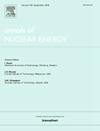MSLB事件模拟的实用建模方法验证:对CFD的贡献
IF 1.9
3区 工程技术
Q1 NUCLEAR SCIENCE & TECHNOLOGY
引用次数: 0
摘要
本文描述了计算流体动力学(CFD)模型的开发和应用,以模拟三回路前科沃伊核电站主蒸汽管线断裂(MSLB)事件期间的流体流动、传热和硼分布。CFD模拟用于生成岩心入口的时变流图,并使用松耦合方法将其集成到瞬态simulation - 3k岩心模型中。模拟预测了反应堆压力容器内复杂的流动模式,其特征是下降管中明显的温度分层和明显的冷羽直接从受影响的冷腿下降。与传统的静态混合假设相比,这种冷却剂的行为显著地影响了流动和硼的分布,在堆芯入口有明显的偏差。利用CFD模拟和内部混合工具获得的混合图,利用simulae - 3k进行的瞬态反应性计算显示,与传统的静态均匀混合图相比,该混合图具有更大的临界余量。本文章由计算机程序翻译,如有差异,请以英文原文为准。
Verification of practical modeling approaches of an MSLB event simulation: A CFD contribution
This article describes the development and application of a Computational Fluid Dynamics (CFD) model to simulate the fluid flow, heat transfer, and boron distribution during a Main Steam Line Break (MSLB) event in a three-loop pre-Konvoi Nuclear Power Plant. The CFD simulations were used to produce time-varying flow maps at the core inlet, which were integrated into a transient SIMULATE-3 K core model using a loose-coupling methodology. The simulations predict complex flow patterns within the reactor pressure vessel, characterized by pronounced temperature stratification in the downcomer and a well-defined cold plume descending directly from the affected cold leg. This coolant behavior significantly influences flow and boron distributions, with notable deviations at the core inlet compared to traditional static mixing assumptions. Transient reactivity calculations conducted with SIMULATE-3 K, utilizing mixing maps derived from the CFD simulations and an in-house mixing tool, show a larger margin to recriticality than traditional static homogeneous mixing maps.
求助全文
通过发布文献求助,成功后即可免费获取论文全文。
去求助
来源期刊

Annals of Nuclear Energy
工程技术-核科学技术
CiteScore
4.30
自引率
21.10%
发文量
632
审稿时长
7.3 months
期刊介绍:
Annals of Nuclear Energy provides an international medium for the communication of original research, ideas and developments in all areas of the field of nuclear energy science and technology. Its scope embraces nuclear fuel reserves, fuel cycles and cost, materials, processing, system and component technology (fission only), design and optimization, direct conversion of nuclear energy sources, environmental control, reactor physics, heat transfer and fluid dynamics, structural analysis, fuel management, future developments, nuclear fuel and safety, nuclear aerosol, neutron physics, computer technology (both software and hardware), risk assessment, radioactive waste disposal and reactor thermal hydraulics. Papers submitted to Annals need to demonstrate a clear link to nuclear power generation/nuclear engineering. Papers which deal with pure nuclear physics, pure health physics, imaging, or attenuation and shielding properties of concretes and various geological materials are not within the scope of the journal. Also, papers that deal with policy or economics are not within the scope of the journal.
 求助内容:
求助内容: 应助结果提醒方式:
应助结果提醒方式:


